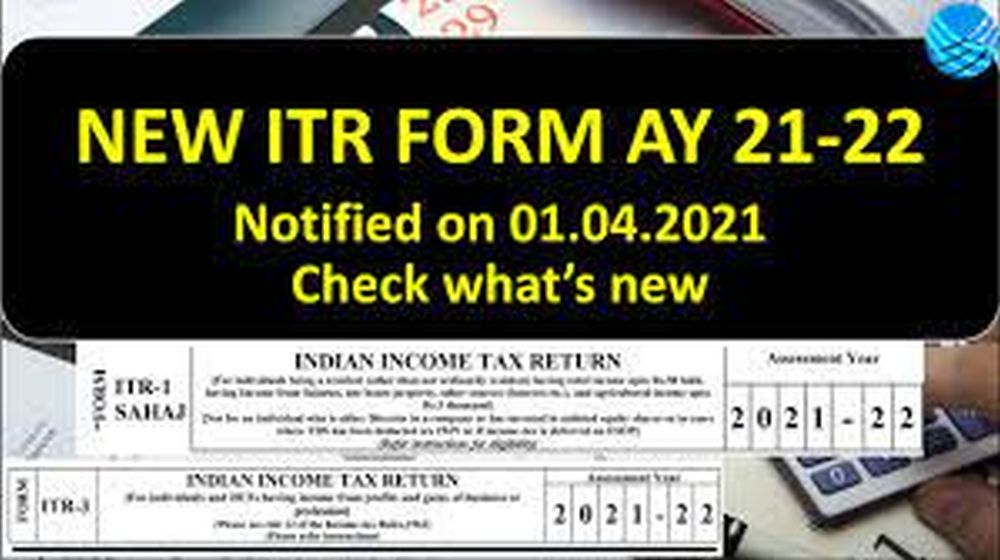The government announced the new ITR form for the fiscal year on March 31, 2021. The ‘ITR’ is a form used by taxpayers to record their earnings (Income-Tax Return). Every year, the central government issues this form. It takes into account the adjustments made by the annual budget. The revised ITR forms for the financial year 2020-21 (the assessment year 2021-22) were announced on March 31, 2021. These are the forms that should be used to file returns for the current tax season.
The old compared. the new tax system
A new or “simplified tax regime” prospect is one of the significant developments this year. This is the 1st year that taxpayers will have to pick between the new system and the one previously in place. “From the baseline exemption of Rs 2.5 lakh to a total income of Rs 15 lakh, the new regime applies tax slabs of 5%, 10%, 15%, 20%, and 25% on each consecutive rise of Rs 2.5 lakh.
However, the taxpayer must renounce several tax deductions and exemptions that were previously available under the previous regime,” said Pritam Goel, founder partner of Tattvam & Co.
The choice of the “regular tax system” or the “simplified tax regime,” according to Aarti Raote, Partner Deloitte India, is based on each taxpayer’s facts. “Those who claim considerable amounts in deductions such as house rent allowance, leave travel aid, housing interest, or chapter VI-A deductions such as 80C or 80E (interest education loan) will find that the old or ordinary tax regime is more favourable. An employee who does not claim such deductions, on the other hand, would benefit from the new streamlined tax structure. To make an informed decision, one can use the tax simulator to determine which regime is best for them,” Raote added. While the selection choice for businesses is more stringent, salaried individuals with income from salary, real estate, and other sources of income can alter their regime every year.
A new website has been launched.
The tax agency unveiled a new website on June 7 to make filing income tax returns easier. Despite specific technological issues, the new portal includes several new features. Apart from a mobile-friendly and user-friendly interface, the user profile section also provides options to update details such as bank accounts, Demat accounts, and sources of income, which will be used in pre-filing ITR after other stakeholders such as employers, banks, and others have filed necessary returns. This would save the taxpayer a significant amount of time when filing taxes. Taxpayers can also offer access to chartered accountants who will be able to conduct appropriate actions on their behalf, such as registering grievances, completing form 15CB, and so on.
There is no monetary limit.
There is no monetary limit on the number of capital gains, dividends, or interest income that must be reported. Only the ITR forms will be pre-filled with it.
Select an ITR form.
ITR-1
- People with an annual income of up to Rs 50 lakh
- Earnings from salary
- Income from a single-family residence
- Other sources of income (interest, etc.) Up to Rs 5,000 in agricultural income
ITR-2
- Individuals and HUFs who do not profit from their business or vocation
- Earnings from salary
- Rental property income
- Other sources of income (interest, etc.) Up to Rs 5,000 in agricultural income
- Profits from capital gains
ITR-3
- Individuals and HUFs who have benefited from a business or profession
- Earnings from salary
- Rental property income
- Other sources of income (interest, etc.) Up to Rs 5,000 in agricultural income
- Profits from capital gains Profits and gains from a business or profession are included in the income category.
ITR-4
Individuals, HUFs, and businesses (other than LLPs) with a total income of up to Rs 50 lakh are eligible.
- Income from business or profession earnings and gains computed under Sections 44AD, 44ADA, or 44AE
- Earnings from salary
- Rental property income
- Other sources of income (interest, etc.)
ITR-5
- Applicable to AOP/BOI/AJP executor, but not to: I Individuals (ii) HUFs (iii) Person submitting Form ITR-7 (iv) Company
- Profits derived from a business or profession
- Profits from capital gains
- Rental property income
- Other sources of income (interest, etc.)
ITR-6
- Businesses that aren’t eligible for Section 11 exemption (Exception for income derived from property held under the faith of wholly for charitable or religious purposes to the extent such payment is applied for charitable or religious purposes in India)
- Earnings from a firm or profession’s profits and gains
- Profits from capital gains
- Rental property income
- Other sources of income
ITR-7
- Individuals who are covered by I Section 139(4A), (ii) Section 139(4B), (iii) Section 139(4C), and (iv) Section 139(4D) (4D)
- Profits from capital gains
- Rental property income
- Other sources of income
- Profits and earnings from a business or vocation

Changes in Income Tax Return Forms